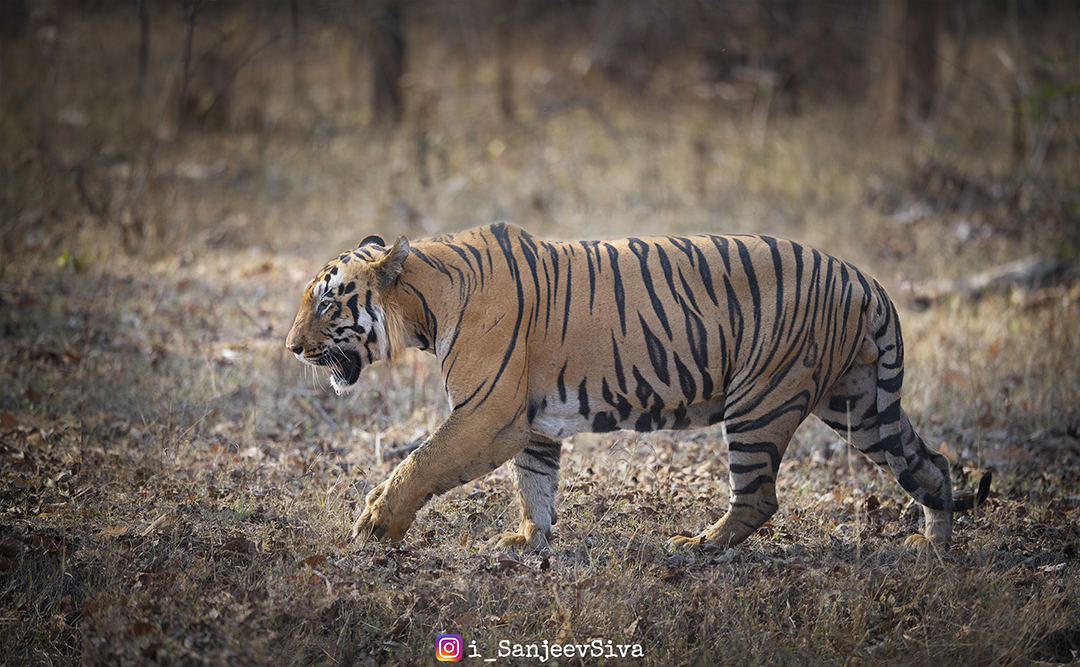Gladiators of Taru
The enchanted land of Taru (so called after the folklore-chieftain who valiantly fought with a tiger) is a familiarly romantic setting in the Central Deccan Plateau, greets you with an fairy charm – a whiff of fresh air from the woods, the lushness of the jungle around, the unsettling fog over the hills, and the sun playing hide and seek from behind the trees, streaks of golden rays illuminated the morning forest-scape, shadows appallingly creeping across the forest floor.
Behind this charm is a perturbing paradox – an element that differentiates Tadoba from the rest of the forests – an unusually high density of war-mongering Herculean male tigers all wanting a chunk of this dominion but when these tigers realize that each of their opponents are formidable, they eschew violence, for a while.
This tropical and subtropical dry-broadleaf and dry-deciduous forest of Tadoba is a realm of savage yet legendary tigers. The presence of riparian habitats concentrates most species around these water sources (during the dry and drought periods of the year) which also attracts predators. But more often than any other forest across India, there is an unusual influx of dominant tigers, year after year, where tigers proclaim their prowess like gladiators in the arena; but the losing-ones don’t give up yet, not before launching a volley of conquests in a do-or-die ferocious struggle for supremacy; or it used to be so.
As the villages relocated and human activity reduced inside the Critical Tiger Habitat, tigers promulgated. The average size of a tiger territory halved or even quartered, with each tiger having an overlapping territory of the rich prey-bases. Though the confrontations were avoided during most times of the year, the eventual would happen with the onset of dry spells.
At the beginning of recorded history, we know of a few dominant males ruling Tadoba with hardly any overlap of territories – the old Katezhari male, Sultan, Hilltop male and W-male (Vasant Bhandara male), Jabbar, Shivaji – responsible for the promulgation of today’s tigers. They were impregnable and were ruling for many years before they aged and were replaced by the next wave of tigers.
These tigers were ruthless and undaunting; they did not intend on sharing territories; no tiger was spared; opponents were destroyed in fierce battles, intruders were driven away or killed, females were forced and shared within themselves, and young ones were killed. These tigers – Tyson (probable son of old Katezhari male), Saturn, Gabbar ruling Tadoba lake area; Yeda Anna (probable son of Sultan), Waghdoh ruling Moharli range; Kakarghat male (probable son of Shivaji) and Gangaram ruling Kolsa and buffers; Narasimha (T-65), Bobadiya ruling Navegaon and buffers – remained archnemesis till they were exiled from their territories.
An exceeding number of males meant that reign of any dominant tiger was reduced to lesser time. This posed a threat to the females and the offspring. Males kill any cubs that do not belong to them, to force the female into copulation. Females too would have a few tricks up the sleeve. They would force the male into thinking that the cubs are his’ and would also not reject the sexual advances of the male, indulging in mock-mating, thus saving the cubs.
The subsequent wave of male tigers upped the ante. They displaced the previous generation with ease, particularly because of the age-advantage. Not-withstanding, they started to share the territories, avoiding conflict but unrelinquishing the territories – V7 (son of Yeda Anna), Ambe-utra male, Bunty (son of Shivaji), Matkasur, Kankajhari (son of Katezhari), Ookhan (son of Yeda Anna), Bajrang, Ghinaji (son of Saturn), Khali. A few had unchallenged territories, but most of them avoided confrontations.

But for a male, confrontations are a part and parcel of life. Threats are imminent and could happen in the form of a wanderer, a conqueror, or an expatriate. No single tiger can consistently outdo its opponents perpetually.
It is that time of the year when the new wave of tigers would launch the conquests, and they already did. A few of the tigers – Dhadiyal, Haider, Tala and Rudra (sons of Kakarghat), Chota Matka (son of Matkasur), Mowgli (son of Gangaram), and Joga (son of Narasimha)
While tigers replacing tigers is a norm, two males however seem to be standing the test of time (unlike any other tiger of Tadoba) like gladiators, the mighty Bajrang and the feisty Matkasur. While Bajrang has been on an expansion spree, since he took over from Waghdoh, Matkasur has been taking a beating but still unrelenting.
Bajrang, still in his prime, has warded off conquests and has more than 8 females under his rule; his territory expands to a sizeable portion of the park. Matkasur could not stand the conquests from both the older males and the younger ones, but after getting gravely injured, he would go into recluse and return with more vigour but not letting go of his territory.
Both Bajrang and Matkasur of unknown lineage, started their conquest at the same time, and still holding onto the territories – Bajrang reigning a vast one, while Matkasur reigning the prime land of Tadoba, each at different ends and with different approaches – like gladiators, depicting the best of the tribe, showcasing potential, courage, strength, tenacity, and sometimes even defeat; remaining as immortal as whiff of fresh air, the unsettling fog and the streaks of morning light in the lush forests of the legendary land of Taru.
